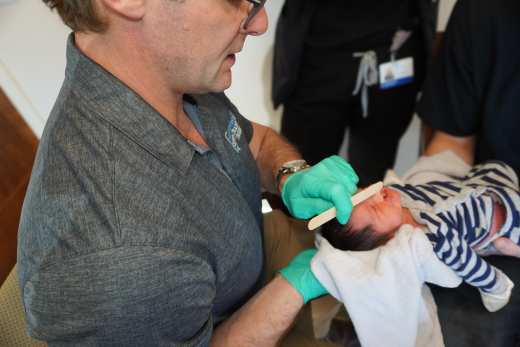
What is the difference between a Cleft Lip & a Cleft Palate?
During the early stages of pregnancy, the left and right sides of a child’s face will initially develop individually, and then fuse together. However, if the sections meet and there is a split in the upper lip, this is called a cleft lip. If the separation occurs in the roof of the mouth, this is called a cleft palate. It’s important to understand the difference between the two birth anomalies as the care and surgeries needed to correct them are substantially different.
In the United States, roughly one out of every 600 children are born with some sort of cleft birth anomaly. This leads to feeding and developmental issues, and although special feeding devices and speech therapy are important aids, surgery is always necessary to help correct the defect.
Cleft Surgery: What to Expect
Depending on the severity of the cleft, children born with a cleft lip typically only require one or two surgeries to correct the split in the lip and enhance their facial features. Following an initial assessment at birth, cleft lip surgeries are often performed as early as 3-6 months of age. Children born with a cleft palate, however, face greater difficulties and require a much more involved surgical plan involving several operations over the course of their developing years and sometimes even beyond. This is because children born with a cleft palate typically always have a cleft lip and because the palate is in an extremely sensitive location. When there is a separation or a hole in the palate, it can make it difficult for food to pass into the esophagus or for air to correctly pass from the lungs. Children with a cleft palate are also more prone to infections in the nose, mouth, and throat.
Much like cleft lip patients, children born with a cleft palate are assessed at birth. Following this, a feeding evaluation is also performed to determine if any special aids, such as syringes, are needed to ensure the child is taking in nutrients. Then, at around 12-16 months, the palate repair is done. Children are also recommended to a speech therapist at this time, and it is common for tubes to be placed in the ears, as well.
Over the next several years, more surgeries, speech therapies, and evaluations/assessments will be performed to determine how the palate is repairing as the face continues to develop. This will be coupled with typical pediatric dental visits. Most often, further cosmetic procedures such as nasal revision surgery are performed once the child has grown past puberty and well into their teenage years. It's important to remember that while this timeline can seem daunting or even overwhelming, children born with a cleft palate often need years of care to help ensure they live healthy, full lives.
Cleft Repair: A Family-Centered Approach to Care
Each case of cleft lip or cleft palate is highly sensitive to both the patient and their family. Understanding and agreeing on a treatment plan is an essential part of making everyone feel safe and confident in their child’s care. For some, the treatment will involve years of extensive surgeries and corrective therapies, therefore you need to find an oral surgeon who believes in supporting the entire family throughout this journey.
Carolinas Centers for Oral & Facial Surgery is nationally recognized by the American Cleft Palate-Craniofacial Association and is only one of five centers (outside of hospitals or universities) capable of providing the elevated level of care and support families need during this time. Each personalized treatment plan is optimized to promote function as well as facial aesthetics, ensuring the best outcomes for your child. Our industry-leading team of surgeons and nurses is ready to walk every step of the way alongside you, providing you with the tools and resources you won’t find anywhere else.
To learn more about our Cleft Center, click here.
Back




